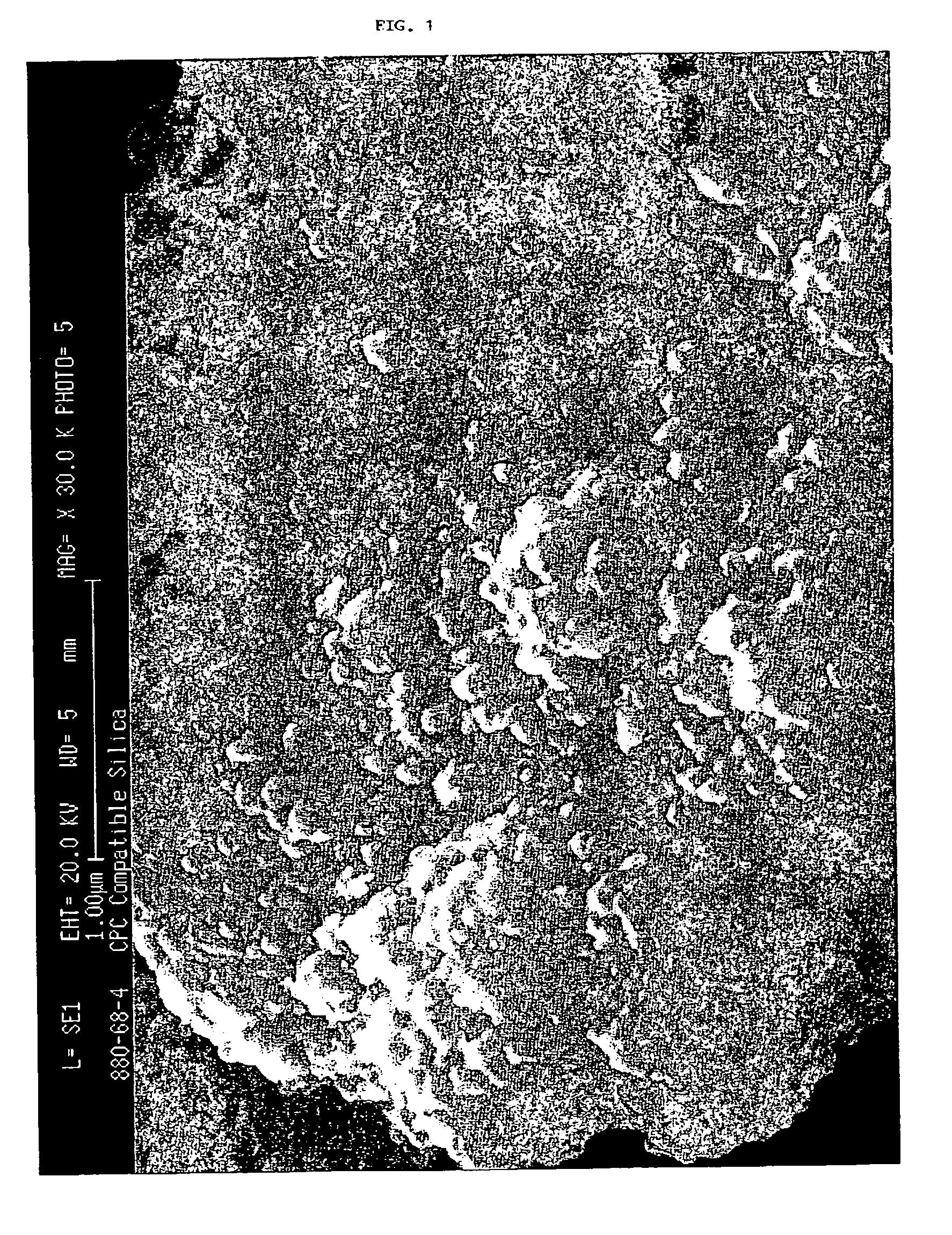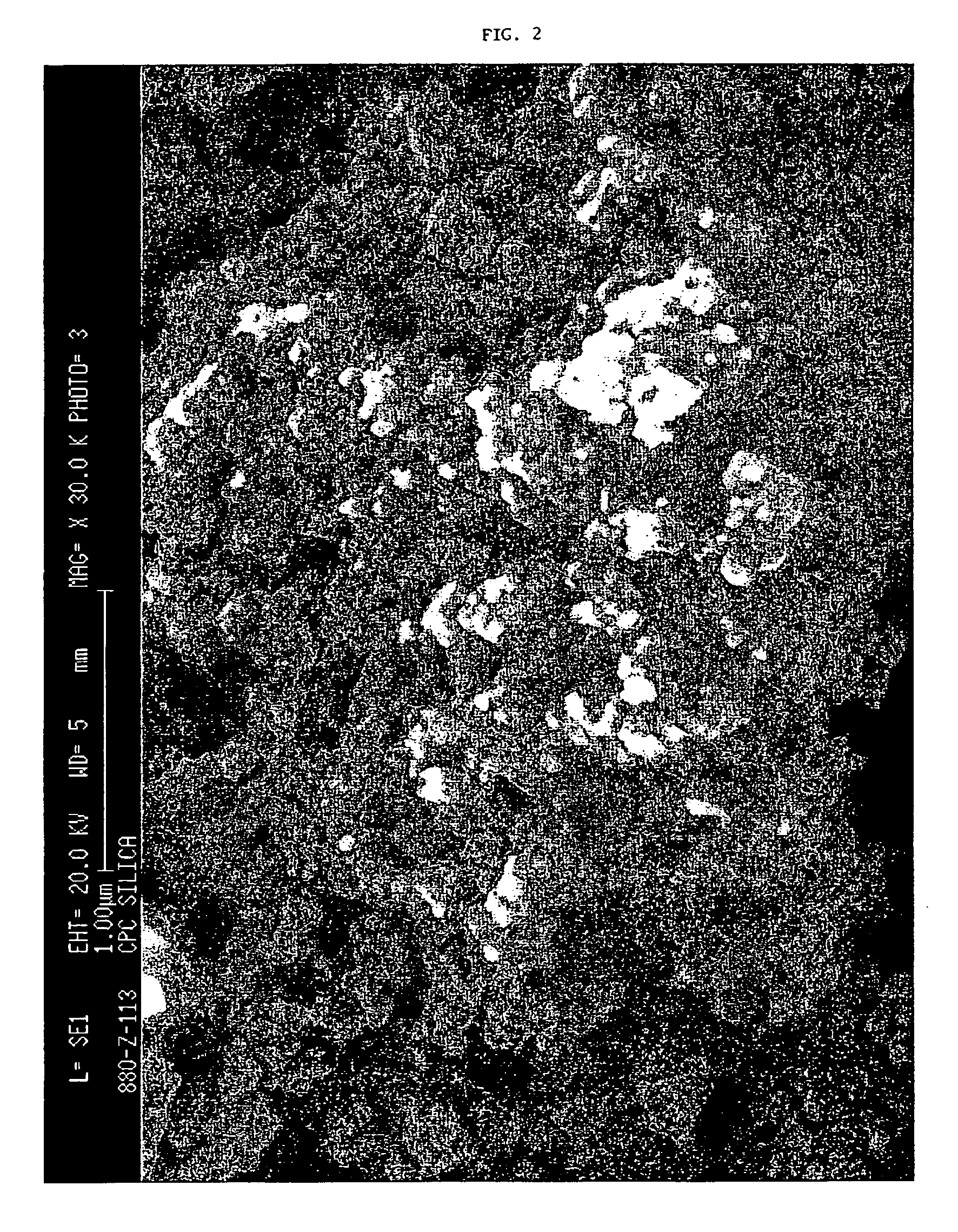Precipitated silica product with low surface area, dentifrices containing same, and processes
a technology of amorphous silica and amorphous silica, which is applied in the field of precipitation amorphous silica, can solve the problems and achieve the effect of reducing the possibility of off-flavors and low surface area
- Summary
- Abstract
- Description
- Claims
- Application Information
AI Technical Summary
Benefits of technology
Problems solved by technology
Method used
Image
Examples
example 1
[0069]40 L of sodium silicate (13%, 3.32 M.R., 1.112 S.G.) was added to a 400-gallon reactor and was heated to 95° C. with stirring at 75 RPM. Sodium silicate (13%, 3.32 M.R., 1.112 S.G.) and sulfuric acid (11.4%) were then simultaneously added to the reactor at rates of 7.8 L / min and 2.3 L / min, respectively, for 47 minutes. After 47 minutes, sodium silicate addition was stopped and the pH was adjusted to 9.5+ / −0.2 with continued addition of sulfuric acid (11.4%). (This formed the substrate silica.) Once the pH reached 9.5, sodium silicate (13%, 3.32 M.R., 1.112 S.G.) and sulfuric acid (11.4%) were simultaneously added at rates of 1.1 L / min and 0.4 L / min, respectively, for 300 minutes(active silica addition time). If necessary, the acid rate was adjusted to maintain pH 9.5+ / −0.2. After 300 minutes, the flow of sodium silicate was stopped and the pH was adjusted to 5.0+ / −0.2 with the addition of sulfuric acid (11.4%) at 2.3 L / min. The batch was digested for 10 minutes at pH 5.0+ / −0.2...
example 2
[0070]40 L of sodium silicate (13%, 3.32 M.R., 1.112 S.G.) was added to a 400-gallon reactor and was heated to 95° C. with stirring at 50 RPM. Once the temperature stabilized at 95° C., a Silverson in-line mixer coupled to the reactor by a re-circulation line was set to 100 Hz with re-circulation of 100 Hz. Sodium silicate (13%, 3.32 M.R., 1.112 S.G.) and sulfuric acid (11.4%) were then simultaneously added to the reactor at rates of 7.8 L / min and 2.3 L / min, respectively, for 47 minutes. After 15 minutes, the stir rate was increased to 75 RPM. After 47 minutes, the Silverson in-line mixer was stopped. Sodium silicate addition was also stopped and the pH was adjusted to 9.5+ / −0.2 with continued addition of sulfuric acid (11.4%). (This formed the substrate silica.) Once the pH reached 9.5, sodium silicate (13%, 3.32 M.R., 1.112 S.G.) and sulfuric acid (11.4%) were simultaneously added at rates of 1.1 L / min and 0.4 L / min, respectively, for 300 minutes (active silica addition time). If ...
examples 3-6
[0071]For these examples, 50 L of sodium silicate (13%, 3.32 M.R., 1.112 S.G.) was added to a 400-gallon reactor and was heated to 95° C. with stirring at 50 RPM. Once the temperature stabilized at 95° C., a Silverson in-line mixer coupled to the reactor by a re-circulation line was set to 100 Hz with re-circulation of 100 Hz. Sodium silicate (13%, 3.32 M.R., 1.112 S.G.) and sulfuric acid (11.4%) were then simultaneously added to the reactor at rates of 9.8 L / min and 2.9 L / min, respectively, for 47 minutes. After 15 minutes, the stir rate was increased to 75 RPM. After 47 minutes, the Silverson in-line mixer was stopped (silica substrate formed) and the flow of sodium silicate (13%, 3.32 M.R., 1.112 S.G.) was adjusted to a specified rate. Once the pH reached 9.5, the sulfuric acid (11.4%) rate was adjusted to maintain pH 9.5+ / −0.2. After a specified active silica addition time, the flow of sodium silicate was stopped and the pH was adjusted to 5.0+ / −0.2 with the addition of sulfuric...
PUM
| Property | Measurement | Unit |
|---|---|---|
| median diameter | aaaaa | aaaaa |
| diameter | aaaaa | aaaaa |
| median diameter | aaaaa | aaaaa |
Abstract
Description
Claims
Application Information
 Login to View More
Login to View More - R&D
- Intellectual Property
- Life Sciences
- Materials
- Tech Scout
- Unparalleled Data Quality
- Higher Quality Content
- 60% Fewer Hallucinations
Browse by: Latest US Patents, China's latest patents, Technical Efficacy Thesaurus, Application Domain, Technology Topic, Popular Technical Reports.
© 2025 PatSnap. All rights reserved.Legal|Privacy policy|Modern Slavery Act Transparency Statement|Sitemap|About US| Contact US: help@patsnap.com



